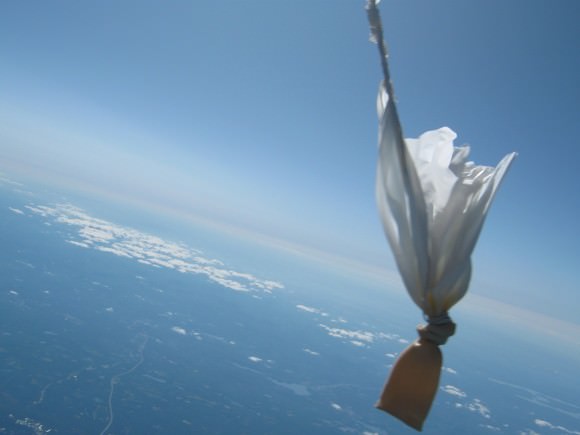A group of MIT students have launched a low-budget satellite to near space, taking images of the curvature of Earth and the blackness of space. Their approach was to use low tech, off the shelf equipment, which included a Styrofoam beer cooler, a camera from eBay, open source software and an inexpensive helium balloon as the launch vehicle in order to do their complete mission launch for less than $150. Total cost? $148. The experience? Priceless, including getting interviewed on CNN and Fox News about their achievement. The best news for the rest of us? They’ll soon be sharing an illustrated step-by-step guide on how to launch your own low-budget satellite.
The team, led by Justin Lee and Oliver Yeh had the goal of seeing Earth from space, but didn’t have a lot of money to do it. They knew they’d have to gather all the materials for less than $150.
[/caption]
Their satellite was a huge success. It reached 93,000 feet (calculated from the linear ascent rate at the beginning of the launch), took several images of Earth from space (see their gallery here) and was retrieved using an inexpensive GPS system.
They say the time lapse video above isn’t all that great because the cooler wasn’t stabilized. But the images are incredible.
Many people have launched balloons (see some of our previous articles, here and here) but this is the lowest price to space anyone has ever accomplished. The students say they hope to be an inspiration to others.

Lee and Yeh caution about making sure future explorers contact the FAA about launching a balloon, and to launch from a safe place so the balloon and equipment doesn’t land in a highly populated area.
Next, they want to do it again, but add a rocket to the balloon to launch their payload even higher.


Am liking it! That top image alone was worth the effort! The lower image shows clues to the construction and is intriguing!
Here’s hoping that everyone reads the entire piece! Especially: “…contact the FAA about launching a balloon, and to launch from a safe place so the balloon and equipment doesn’t land in a highly populated area.”
Hmm, wuz my first fuzzy thought! High speed turbofan ingestion debris anyone?
M.I.T. =
~@; )
I’m planning a launch just like this. The plan is to use hydrogen and burn the gas to release pressure on the bal… – but I’m not allowed to talk about my own ideas here or promote my own site explaining anything, so never mind, but BRAVO for them!
A real life color picture, without any filters or artifical enhancements. Congratulations – the pictures are just fantastic. Breathtaking.
I wish someone would put a real color camera in orbit around Mars. I would love to see the seasonal changes there as they really look. I’ll be sending a copy of the book [Title Withheld by writer of comment] so you see why.
Students in the UK did something similar last year with teddy bears.
I must get the time to do this someday. Don’t forget to send up a lock of your hair, thats how we get to space for cheap. 🙂
Aqua, my thoughts exactly! This spells disaster for air traffic control!!
This is really interesting. Just goes to show that we don’t always have to throw money at everything in order to achieve acceptable (in this case outstanding) results. I think this will inspire other creative and innovative ideas of exploration.
Not only that, this was probably the ‘greenest’ flight to near space and back yet. I think we’ll be seeing more of this—I know I’d like to try it! Although, I do agree with other posters about air traffic control and the disasters this could cause. We’re doomed to get more laws!
Nice post, I’m glad I caught this one.
Impressive budget. But these guys aren’t unique. This feat has been performed several times in the past (for instance: http://sunsite.utk.edu/~mcoffey/ux-1/ ).
Did I actually read *satellite*?